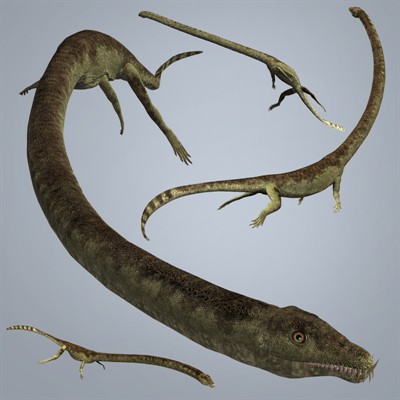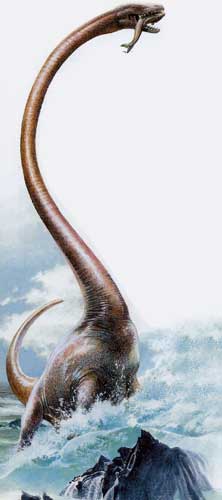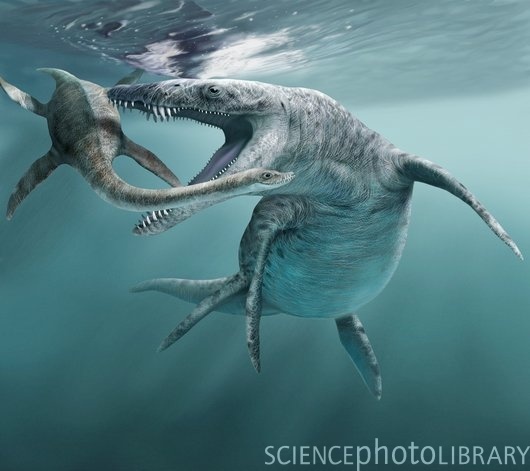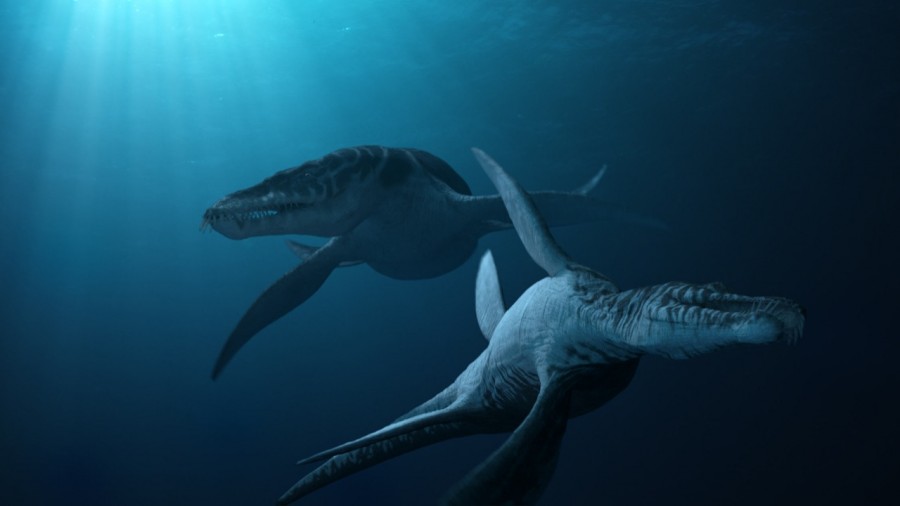Marine Reptiles: Dragons of the waters
Nothosaurus.
Nothosaurus was/is a semiaquatic reptile that is somewhat similar to a Plesiosaur in general body plans (design). It is dated by Evolutionists to the Late Triassic between 240-210 mya (million years ago), though most Christians do not accept these dates. It is actually not a Plesior of any kind but is in it's own Order and Family, though can be generally grouped with other marine reptiles. It's name means "False Reptile".
Fossil remains have been found in Northern Africa, China, Israel, Russia, Germany, Italy, Switzerland and the Netherlands. Many remains have been found in sediments deposited in caves, likely during the Flood.
Nothosaurus was around 10-13 feet long but some other species of Nothosaurs attained alrger sizes. Some have theorized that it may have had fins, at least one on it's tail but evidence for this hasn't been established. It had a motuhful of needle-like teeth perfect for catching fish and other aquatic prey and it likely used it's webbed feet and tial to propel it through the water. It's head, while long and crocodile-like, was relatively broad and flat when viewed from above. Some people have compared Nothosaurs to a reptilian Seal.
Tanystropheus.

Discovered in 1886 and known from many well preserved and complete skeletons, Tanystropheus is a well established dinosaur species and is quite well known. At around 20 feet long, it is also a fairly good sized species. Astoundingly, over half it's length is comprised of it's neck at around 10 feet long, it's neck would make the animals look awkward to some. It is believed that Tanystropheus was largely aquatic based on it's teeth and fossilized findings of fish scales and parts of cephalopd tentacles have been found in the stomachs of Tanystropheus, lending more evidence of a semiaquatic life. What is interesting is that even though Tanystropheus' neck comprised over 50% of it's total length, it had only 10 neck vertebrae, leading some people to speculate that it couldn't bend it's neck much, though it seems unlikely since the animal would have used it's neck more than msot other body parts, especially for hunting and getting air from the surface.
Evolutionary dating places Tanystropheus as a species about 232 million years ago during the middle of the Triassic period. This is much longer ago than Human beings are supposed to have evolved onto the scene.

It is widely believed that Tanystropheus would snatch fish from the water while sitting out of the water. another theory regarding the use of it's long neck is that it would use it in a way akin to softshell turtles and stuck the out to get a breath while staying submerged. it is likely that both scenarios are true and that the animal stayed in the water much of t's time because it would be easier for it to maneuver it's awkward, over sized neck in the water than on land where it's neck would have been harder to support.

Tanystropheus has been suggested as the identity of the famous lake monster Champ, an idea believed by many based on eye witness descriptions. You can learn more about the Lake Champlain creatures in our Cryptozoology section. A video showing what appears to be the clearest shot of a lake Champlain monster to date and seems to show a Tanystropheus just under the waters' surface beside a boat. This video ca be viewed in our Videos section. Some still shots of the creature in the video can be viewed in the Photos of real events section as well.
Liopleurodon.

Liopleurodon is a giant marine reptile dated to the middle of the Jurassic period, about 160-155 million years in the past. Supposedly living only for 5 million years, not long as far as the Evolutionary timeline is concerned but certainly longer than the Biblical timeline of our history states animals have lived.
The first fossil remains of Liopleurodon were unearthed in France in 1873 by Henri Emil Sauvage near Bologne-sur-Mer. The find consisted of no more than 3 teeth of a as of then unidentified animal species but at the time was not assigned to any particular group of animals. Currently fossils are known from France, England, Russia and Germany, meaning that at the time these fossils were made most if not all specimens of Liopleurodon lived in the area that is now Europe. Though this has nothing to do with where members of the species lived after the event that fossilized said specimens occurred since fossilization only tells us the rough area where that exact animal was buried.

As with other marine reptiles and the Pterosaurs, Liopleurodon is not a true dinosaur but is included along with them for all intended purposes just as they are in T.V. specials, books and other websites. Liopleurodon was a large marine reptile, estimated at anywhere between 15-34 feet long, and possibly longer as believed by some. However most estimates now place it's adult size around 23 feet long with a roughly 5 foot long skull being the largest example. It belongs to the subgroup Pliosaur which are included in the Plesiosaur family. Most Plesiosaurs had long necks such as Elasmosaurus, however Pliosaurs had short, stout necks and large heads attached to bulky bodies with powerful flippers and short tails.
Liopleurodon has been compared to Killer Whales, only larger and reptilian, and sometimes accused of being even fiercer predators. Liopleurodon is thought to have used it's 5 foot long jaws to grab prey in mid-water and may have even bit some prey in half. Though as with most habits of presumably extinct animals it is merely hypothesis.


Liopleurodon was indeed a fierce predator and could have easily decapitated long necked Plesiosaurs. And although they are normally portrayed as evidence of Evolution as made famous by Charles Darwin, they point much more towards evidence for Creation. They are specialized sea dwelling reptiles that were once plentiful and now may be extinct. According to some historical accounts humans encountered these fascinating beasts and were even killed by them on some occasions. These events certainly inspired legends of sea monsters and sea dragons, though many discount this as mere myth.
Plesiosaurs.

*Elasmosaurus
The term Plesiosaur refers to several animals from different taxonomic rankings, however, the Elasmosaur is usually depicted as the "standard" Plesiosaur. Plesiosaurs were a group of aquatic carnivorous reptiles and it has been suggested that they could travel on to land. Plesiosaurs had large bodies, two pairs of flippers instead of feet, a short to medium length tail depending on the species, and long necks with a small head full of sharp, pointed teeth. Depending on the species, they could range from 15 to 70 feet long. Plesiosaurs were most likely predominately piscovorous, meaning that they mainly ate fish. However it is very possible that they would have eaten any available flesh based food source and may have occasionaly scavenged floating carcasses or caught animals near and on shore.
It is believed by some that Plesiosaurs could not have possibly lifted their neck and head above the surface of the water in the "swan like" fashion often portrayed in pictures and paintings because gravity would not allow it, however this is theory not fact, and without knowing the muscle structure of these animals it is a largely unfounded theory. In fact many thousands of eye witness reports describe Plesiosaur type animals doing just that, raising their heads up high to look around or even hunt. It seems that eye witness testimony of such an action would be the best evidence of whether or not they could lift their heads high above the waters surface. Some scientists believe one way of hunting implemented by these animals was to indeed hold their heads high out of the water to look into it for prey and plunge down onto them, this has actually been reported in one chilling encounter off the coast of Florida which is mentioned later.
*Woolungasaurus catching fish
There have been tens of thousands of reported sightings of creatures said to be or look like Plesiosaurs in the last few hundred years, including some strange reports of creatures coming onto land into peoples yards, stealing livestock to eat. Many reports have come from people at sea such as sailors. During the days of sailing ships between the 1500's and 1900 hundreds to thousands of reports of Long necked sea monsters were reported.
In 1734 Hans Egede reported seeing a lareg sea serpent off the western coast of Greenland:
[There] appeared a very terrible sea-animal, which raised itself so high above the water, that its head reached above our maintop. It had a long, sharp snout, and blew like a whale, had broad, large flippers, and the body was, as it were, covered with hard skin, and it was very wrinkled and uneven on its skin; moreover, on the lower part it was formed like a snake, and when it went under water again, it cast itself backwards, and in doing so, it raised its tail above the water, a whole ship length from its body. That evening, we had very bad weather.
In another telling of the encounter Hans said this:
"(We) saw a most terrible creature, resembling nothing they saw before. The monster lifted its head so high that it seemed to be higher than the crow's nest on the mainmast. The head was small and the body short and wrinkled. The unknown creature was using giant fins which propelled it through the water. Later the sailors saw its tail as well. The monster was longer than our whole ship"
The preceding account sounds remarkably similar to a Plesiosaur of some species from the description given, this description fits many reported sea monsters and sea serpents throughout the ages. It seems likely, given all the reports throughout history, that these animals have survived into recent and likely current times with humans.
*Morenosaurus
There is even a confirmed account of a Plesiosaur killing several divers off the coast of Florida. This story has been confirmed by the one man that survived as well as the mother of one of the men young men that died. The one young man that survived drew a sketch of the animal that killed his friends. He now refuses to talk about the incident. The following picture was drawn by the man that survived, The full story of the event can be heard during the Kent Hovind video series on Living Dinosaurs in the Videos section of our website. It is a disturbing story.

Mosasaurus.
The first remains of a Mosasaurus were discovered in the Netherlands in 1764. Since then it has been a popular example of a dinosaur (techniquely swimming reptile). Originally thought to be a fish, then a crocodile, then a type of sperm whale and then a type of giant monitor lizard. It was not until 90 years later in 1854 that it was discovered that the animal had flippers and not feet and was classified as a swimming reptile.
Mosasaurus was a large marine reptile, one of the largest of its Genus at maximum lengths of about 60 feet (15 meters). It is believed to be the largest marine reptile yet scientifically described. There have been a number of accounts throughout history of animals that strongly resemble that description of a Mosasaurus, as well as several depictions of creatures in ancient art that look very much like Mosasaurus'.

In June 1983, a carcass was found on Bungalow Beach in Gambia, but was unavailable for analysis by those who tried to identify it. It was found and examined by Owen Burham who had no camera, and so was only able to bring back a description and measurements.Working on these, noted zoologist Dr Karl P.N. Shuker short-listed six possible identities. Only one, the Shepherd’s Beaked-whale (Tasmacetus shepherdi), was a creature known to be still living in today’s oceans. However, he considers it as the least likely of them. The other five possibilities were prehistoric marine animals. Two of these bear out the description of the leviathan, and of the creature seen by the U28. One was the mosasaur, and the other was a thalattosuchian, a kind of sea-crocodile supposedly extinct for 110 million years. Dr. Shuker believes the latter to be the most likely contender.
One sighting of such a creature occurred in the North Atlantic during World War I with the sinking of the British steamer Iberian by the German U-boat U28. Some seconds after the Iberian had been torpedoed and sunk, there was an underwater explosion. The submarine commander and some of his officers reported:
‘A little later pieces of wreckage, and among them a gigantic sea-animal, writhing and struggling wildly, were shot out of the water to a height of 60 to 100 feet [18 to 30 metres] …‘We did not have the time to take a photograph, for the animal sank out of sight after 10 or 15 seconds …‘It was about 60 feet [18 metres] long, was like a crocodile in shape and had four limbs with powerful webbed feet and a long tail tapering to a point.’
Kronosaurus.

First described in 1924 by Logman in Queensland, Australia, the first estimate of its length was 43 feet in length, but recent estimates have lowered to roughly 33 feet. Being a Pliosaur, a subgroup of Plesiosaurs, the ancient marine reptiles, Kronosaurus is not truly a dinosaur, but is often called one or included in any dinosaur related media, just as Pterosaurs are.
Kronosaurus gets it's name from the Greek titan Kronos, sometimes Cronus. It's name therefore translates as "Kronos Lizard". Kronosaurus being a Pliosaur, was not built like long necked Plesiosaurs . It had a large head in relation to it's body size set on a short, thick neck and used it's large flippers to propel itself through the water. As a Pliosaur, Kronosaurus is believed to have been a fierce predator, however there is in reality little physical evidence to support the notion, meaning currently we are not 100% sure of it's diet.
For years many researchers have pondered the identity of the Leviathan described in the book of Job. Some have suggested that it may have been a Pliosaur such as Kronosaurus. It is possible that such a large aquatic reptile would fit the description of the Leviathan but we may never know until the new Earth, when God restores everything to it's original and glorious state as was intended in the beginning.
